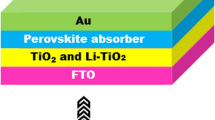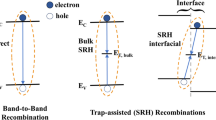Abstract
The strategy to reduce the internal and external sources of heat generation is arguably the general goal of optimizing the performance of the photovoltaic systems faced by many technologists. Therefore, in this research, an optoelectronic coupled thermal model is applied to investigate a part of internal losses affecting the performance of the perovskite solar cell (PSC) by COMSOL Multiphysics package. After the initial simulation of an inorganic metal oxide charge transporting materials-based inverted PSC, four sources of internal heat generation, including thermalization, non-radiative, Joule, and Peltier, are studied on this proposed structure in detail. By calculating the efficiency obtained from the current density–voltage curve of reference PSC without temperature distribution with the efficiencies of the cell at the temperature raised using each of the internal heat sources, it is found that thermalization and non-radiative heat are the main efficiency-limiting factors. In contrast, Peltier and Joule heat only account for tiny proportion of the total heat. Moreover, total heat generation calculated from all internal loss sources shows an increased temperature from 293.16 to 303.08 K, which leads to a drop in efficiency from 14.74 to 13.51%. This detailed simulation analysis reveals that the knowledge of internal loss sources in devices can be highly instructive for applying appropriate techniques to mitigate parasitic heating in the PSCs.










Similar content being viewed by others
Data availability
All data generated or analyzed during this study are included in this article.
References
Achuo, E.D., Miamo, C.W., Nchofoung, T.N.: Energy consumption and environmental sustainability: What lessons for posterity? Energy Rep. 8, 12491–12502 (2022)
Aqachmar, Z., Sassi, H.B., Lahrech, K., Barhdadi, A.: Solar technologies for electricity production: an updated review. Int. J. Hydrogen Energy 46, 30790–30817 (2021)
Asongu, S.A., Agboola, M.O., Alola, A.A., Bekun, F.V.: The criticality of growth, urbanization, electricity and fossil fuel consumption to environment sustainability in Africa. Sci. Total Environ. 712, 136376 (2020)
Bodong, S., Wiseong, J., Chengmeng, L., Khakichi, A.: Economic management and planning based on a probabilistic model in a multi-energy market in the presence of renewable energy sources with a demand-side management program. Energy. 269, 126549 (2023)
Chakrabartty, J., Islam, M.A., Reza, S.: Performance analysis of highly efficient 2D/3D bilayer inverted perovskite solar cells. Sol. Energy. 230, 195–207 (2021)
Charan, A.K., Kumar, R., Balunaik, R.: Evaluation of convective heat transfer coefficient and heat transfer rate through aluminium metal matrix composite fin made by stir casting. Mater. Sci. Eng. 1057, 012038 (2021)
Haider, S.Z., Anwar, H., Manzoor, S., Ismail, A.G., Wang, M.: A theoretical study for high-performance inverted p–i–n architecture perovskite solar cells with cuprous iodide as hole transport material. Curr. Appl. Phys 20, 1080–1089 (2020)
Hao, D., Qi, L., Tairab, A.M., Ahmed, A., Azam, A., Luo, D., Pan, Y., Zhang, Z., Yan, J.: Solar energy harvesting technologies for PV self-powered applications: a comprehensive review. Renew. Energy 188, 678–697 (2022)
Hasani, E., Sharifat, M.: Effect of metal-oxide films on CdTe-based solar cell performance: a numerical simulation of 52.62%-efficient solar cell. Sol. Energy 249, 369–386 (2023)
Heo, D.Y., Jang, W.J., Kim, S.Y.: Recent review of interfacial engineering for perovskite solar cells: effect of functional groups on the stability and efficiency. Mater. Today Chem. 26, 101224 (2022)
Hu, T., Hou, H., Peng, J., Wu, Q., He, J., Yu, H., Liu, R., Hou, T., Zhou, X., Zhang, M., Zhang, X., Yang, X., Sun, Y., Li, X., Bai, Y.: 4-Tert-butylpyridine induced Ni3+/Ni2+ ratio modulation in NiOx hole transport layer towards efficient and stable inverted perovskite solar cells. Mater. Today Energy 32, 101245 (2023)
Jahantigh, F., Ghorashi, S.M.B.: Optical simulation and investigation of the effect of hysteresis on the perovskite solar cells. Nano Brief. Rep. Rev. 14, 1950127 (2019)
Kong, L., Liu, G., Gong, J., Mao, H.K.: Simultaneous band-gap narrowing and carrier-lifetime prolongation of organic–inorganic trihalide perovskites. Proc. Natl. Acad. Sci. USA 113, 8910–8915 (2016)
Konig, D., Casalenuovo, K., Takeda, Y., Conibeer, G., Guillemoles, J.F., Patterson, R., Huang, L.M., Green, M.A.: Hot carrier solar cells: principles, materials and design. Phys. E Low Dimens. Syst. Nanostruct. 42, 2862–2866 (2010)
Kumar, B., Campbell, S.A., Ruden, P.P.: Modeling charge transport in quantum dot light emitting devices with NiO and ZnO transport layers and Si quantum dots. J. Appl. Phys. 114, 044507 (2013)
Li, D., Huang, Y., Ren, Z., Amini, A., Djurišić, A.B., Cheng, C., Li, G.: Recent progress of inverted organic–inorganic halide perovskite solar cells. J. Energy Chem. 79, 168–191 (2023)
Mehdizadeh-Rad, H., Singh, J.: Influence of interfacial traps on the operating temperature of perovskite solar cells. Materials. 12, 2727 (2019a)
Mehdizadeh-Rad, H., Singh, J.: Simulation of perovskite solar cell temperature under reverse and forward bias conditions. J. Appl. Phys. 126, 153102 (2019b)
Mehdizadeh-Rad, H., Ram, K.S., Mehdizadeh-Rad, F., Ompong, D., Setsoafia, D.D.Y., Elumalai, N.K., Zhu, F., Singh, J.: Sources of thermal power generation and their influence on the operating temperature of organic solar cells. Nanomaterials. 12, 420 (2022)
Mehdizadeh-Rad, H., Mehdizadeh-Rad, F., Zhu, F., Singh, J.: Heat mitigation in perovskite solar cells: The role of grain boundaries. Sol. Energy Mater. Sol. Cells. 220, 110837 (2021)
Mozaffari, S., Nateghi, M.R.: Recent advances in solar rechargeable seawater batteries based on semiconductor photoelectrodes. Top. Curr. Chem. 380, 1 (2022)
Saxena, P., Gorji, N.E.: COMSOL simulation of heat distribution in perovskite solar cells: coupled optical–electrical–thermal 3-D analysis. IEEE J. Photovolt 9, 1693–1698 (2019)
Shang, A., An, Y., Ma, D., Li, X.: Optoelectronic insights into the photovoltaic losses from photocurrent, voltage, and energy perspectives. AIP Adv. 7, 085019 (2017)
Shen, G., Dong, H., Yang, F., Ng, X.R., Li, X., Lin, F., Mu, C.: Application of an amphipathic molecule at the NiOx/perovskite interface for improving the efficiency and long-term stability of the inverted perovskite solar cells. J. Energy Chem. 78, 454–462 (2023)
Sherkar, S.T., Momblona, C., Gil-Escrig, L., Ávila, J., Sessolo, M., Bolink, H.J., Koster, L.J.A.: Recombination in perovskite solar cells: significance of grain boundaries, interface traps, and defect ions. ACS Energy Lett. 2, 1214–1222 (2017)
Wang, Z., Liu, L., Wang, Y., Ma, Y., Yang, Z., Wan, M., Zhu, H., Mahmoudi, T., Hahn, Y.B., Mai, Y.: Green antisolvent-mediators stabilize perovskites for efficient NiOx-based inverted solar cells with Voc approaching 1.2 V. Chem. Eng. J. 457, 141204 (2023)
Xu, L., Liu, W., Liu, H., Ke, C., Wang, M., Zhang, C., Aydin, E., Al-Aswad, M., Kotsovos, K., Gereige, I., Al-Saggaf, A., Jamal, A., Yang, X., Wang, P., Laquai, F., Allen, T.G., Wolf, S.D.: Heat generation and mitigation in silicon solar cells and modules. Joule. 5, 631–645 (2021)
Yandri, E., Hagino, N.: Joule heating estimation of photovoltaic module through cells temperature measurement. Int. J. Power Electron. Drive Syst. 13, 1119–1128 (2022)
Yang, S., Ma, W., Zhang, Z., Zhu, J., Liu, Y., Zhang, H., Mao, Y.: Inverted perovskite solar cells based on inorganic hole transport material of CuInS2 with high efficiency and stability. Sol. Energy. 230, 485–491 (2021)
You, J., Meng, L., Song, T.B., Guo, T.F., Yang, Y., Chang, W.H., Hong, Z., Chen, H., Zhou, H., Chen, Q., Liu, Y., Marco, N.D., Yang, Y.: Improved air stability of perovskite solar cells via solution-processed metal oxide transport layers. Nat. Nanotechnol. 11, 75–81 (2016)
Yuan, Q., Tang, X., Shu, Q., Zhu, B., Cai, J., He, Y., Zhou, D.Y., Feng, L.: Double-side healing at CsPbI2Br/ZnO interface by bipyrimidine hydroiodide enables inverted solar cells with enhanced efficiency and stability. J. Chem. Eng. 435, 134760 (2022)
Zandi, S., Jamshidi Seresht, M., Khan, A., Gorji, N.E.: Simulation of heat loss in Cu2ZnSn4SxSe4x thin film solar cells: a coupled optical–electrical–thermal modeling. Renew. Energy 181, 320–328 (2022)
Zhang, W., Shen, H., Yan, P., Zhang, J.: Interfacial engineering of sputtered NiOx for enhancing efficiency and stability of inverted perovskite solar cells. Sol. Energy. 248, 128–136 (2022)
Acknowledgements
We would like to thank Dr. Morteza Maleki for the additional training of the software and the very informative information for upgrading our simulation results.
Funding
This research did not receive any specific Grant from funding agencies in the public, commercial, or not-for-profit sectors.
Author information
Authors and Affiliations
Contributions
All authors contributed to the simulations, collection and analysis of data, and the first author wrote the main text of the article.
Corresponding author
Ethics declarations
Conflict of interest
The authors declare that they have no conflict of interest.
Ethical approval
This declaration is “not applicable”.
Additional information
Publisher’s Note
Springer Nature remains neutral with regard to jurisdictional claims in published maps and institutional affiliations.
Rights and permissions
Springer Nature or its licensor (e.g. a society or other partner) holds exclusive rights to this article under a publishing agreement with the author(s) or other rightsholder(s); author self-archiving of the accepted manuscript version of this article is solely governed by the terms of such publishing agreement and applicable law.
About this article
Cite this article
Mozaffari, S., Kiamehr, Z. A theoretical study on internal losses of heat generation in inorganic metal oxide charge transporting layers-based inverted PSC. Opt Quant Electron 55, 826 (2023). https://doi.org/10.1007/s11082-023-05119-7
Received:
Accepted:
Published:
DOI: https://doi.org/10.1007/s11082-023-05119-7




